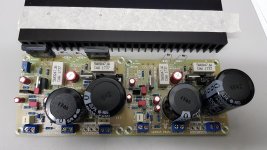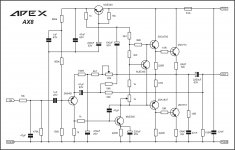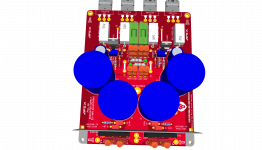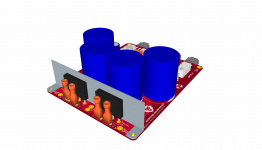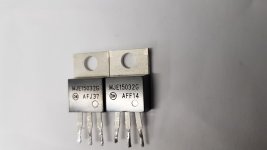Sorry Prasi, the position for noobest of noob is already taken, that would be me my friend 🙂
I’ll check for oscillating after replace R5. I hooked up a speaker this morning and am liking the sound very much so far.
I’ll check for oscillating after replace R5. I hooked up a speaker this morning and am liking the sound very much so far.
can some one help me set up the sim file for apex regulated psu? I am noobest of noob with spice.
i want to see what is adjustment range with different values...
regards
Prasi
Hi Prasi
Let me know which values you want to be able to adjust and I'll see what I can do.
Hello avtech,
Thanks. basically the 3k3, zener diode and the R7 /R5 combo adjustment (this is actually a trimmer of 2k2 value).
Also the other commands /set up that make it a PSU.... proper.
I also wonder if its possible to see transient response of regulator when the load demand (amp) varies.
regards
Prasi
Thanks. basically the 3k3, zener diode and the R7 /R5 combo adjustment (this is actually a trimmer of 2k2 value).
Also the other commands /set up that make it a PSU.... proper.
I also wonder if its possible to see transient response of regulator when the load demand (amp) varies.
regards
Prasi
Almost ready to mount on the heatsink and test. Looking forward to getting these boards fired up.
I didn't get a reply r.e. using a 1.6A SMPS but it looks like each board will consume around 1.25A, so I'm gonna try these out on an old 48v 8.3A CNC SMPS I have in the workshop.
I didn't get a reply r.e. using a 1.6A SMPS but it looks like each board will consume around 1.25A, so I'm gonna try these out on an old 48v 8.3A CNC SMPS I have in the workshop.
Attachments
looking very nice there avtech, the red caps from wurth electronics?
All the best for first fire up.
regards
prasi
All the best for first fire up.
regards
prasi
Thanks Prasi.
Yes, the electrolytics are from Wurth (and Cornell), and some WIMA Film caps. Fischer 1.6c/W heatsink should do the job.
Yes, the electrolytics are from Wurth (and Cornell), and some WIMA Film caps. Fischer 1.6c/W heatsink should do the job.
avtech23,
I don't know the power rating of my SMPS. It's taken out of some malfunctioning unit. I think that your 1,6A SMPS will be enough to power the amp, at least for low to moderate output power.
I don't know the power rating of my SMPS. It's taken out of some malfunctioning unit. I think that your 1,6A SMPS will be enough to power the amp, at least for low to moderate output power.
Great progress avtech, nearly there. I like the tape on the Heatsink idea, I was wondering what would be an easy method, yours looks like the goods.
Thanks Bix.
I drilled and tapped M3 holes in the heatsink using the transistor holes as reference. An automatic centre punch is invaluable for making the holes accurate and only cost about $5 shipped from China.
The other method I've used is to measure the centres, drill and tap then install the transistor. Then it's a case of soldering the transistors onto the board in position. This is good on cheaper boards to make sure the solder pads aren't loaded up as they can be quite fragile (can be quite fiddly though so I tend to do the first method).
I drilled and tapped M3 holes in the heatsink using the transistor holes as reference. An automatic centre punch is invaluable for making the holes accurate and only cost about $5 shipped from China.
The other method I've used is to measure the centres, drill and tap then install the transistor. Then it's a case of soldering the transistors onto the board in position. This is good on cheaper boards to make sure the solder pads aren't loaded up as they can be quite fragile (can be quite fiddly though so I tend to do the first method).
AX6 connected to loudspeakers. As usual the sound has classic current feedback atributes, easy-going, relaxed, organic and musical in a way that no voltage feedback amp of today can achieve. If you want artificial brightness and sharpness you can get it with VFA but if your cup of tea is smoothness and fluidity then you should stick to this topology. No doubt that many builders would prefer the sound of this amp in spite of somewht higher overall distortions.
I did not have any trouble with SMPS in practice listening to CDs, although when I find suitable transformer I shall build linear regulated PSU. It's certainly better to avoid loads of ultrasonic noise that SMPS radiates to nearby appliances. (My FM radio reacted!) I shall try one of Prasi's boards for Apex regulated PSU or cap multiplier. Can't wait to see results of simulation.
I did not have any trouble with SMPS in practice listening to CDs, although when I find suitable transformer I shall build linear regulated PSU. It's certainly better to avoid loads of ultrasonic noise that SMPS radiates to nearby appliances. (My FM radio reacted!) I shall try one of Prasi's boards for Apex regulated PSU or cap multiplier. Can't wait to see results of simulation.
Hello Ivan,
That's a very good review . Thank you for posting.
I am also a fan of relaxed and musical sounding amps and I am sure I am gonna like it too.
I am sure APEX regulated PSU is going to make it sound even better.
regards
Prasi
That's a very good review . Thank you for posting.
I am also a fan of relaxed and musical sounding amps and I am sure I am gonna like it too.
I am sure APEX regulated PSU is going to make it sound even better.
regards
Prasi
Last edited:
Last amplifier that I know of that used singleton input and quasi outputs, produced by well known company, was Audio Innovations Alto back in the early 90's. That amplifier was extremely well received by reviewers in hi-fi press.
There is thread about that amp on this forum:
Audio Innovations Alto
Also this: Review: Audio Innovations Alto integrated amplifier | gramophone.co.uk
And review in Hi Fi Choice Audio Innovation Alto
There is thread about that amp on this forum:
Audio Innovations Alto
Also this: Review: Audio Innovations Alto integrated amplifier | gramophone.co.uk
And review in Hi Fi Choice Audio Innovation Alto
Thanks (not) to Farnell / Element14
First board testing didn't quite go as planned tonight.
Very unstable bias and uncontrollable runaway. Pulled the plug pretty quick but the outputs got toasty hot...
Turns out that I had 2 MJE15032s on that board.. had a look at board 2 and I have 1x MJE15032 and 1x MJE15033.
So I'd been supplied 3x PNP and 1x NPN. 😡 I checked the first transistor of each bag while assembling to make sure I'd identified the correct bag, stupidly trusting that what was in the bag was what I'd ordered.
FFS.
😡
First board testing didn't quite go as planned tonight.
Very unstable bias and uncontrollable runaway. Pulled the plug pretty quick but the outputs got toasty hot...
Turns out that I had 2 MJE15032s on that board.. had a look at board 2 and I have 1x MJE15032 and 1x MJE15033.
So I'd been supplied 3x PNP and 1x NPN. 😡 I checked the first transistor of each bag while assembling to make sure I'd identified the correct bag, stupidly trusting that what was in the bag was what I'd ordered.
FFS.
😡
Attachments
So I'd been supplied 3x PNP and 1x NPN.
I meant 3x NPN and 1x PNP of course. Long day.
I meant 3x NPN and 1x PNP of course. Long day.
I bought in an old Maplin amplifier in need of repair.
I checked all components and they all buzzed out ok.
But still it didn't work.
The voltages around one particular transistor were wrong but it diode checked ok.
It was then I realised it was a pnp instead of an npn.
Someone had tried to fix it with the wrong transistor !
The transistor number had been rubbed off so I couldn't check it.
Its hard enough trying to fix things with correct components in.
ok, so even good distributors like element14 make mistakes, probaby a human error while packaging small qty. I always get confused with onsemi part nos, be it to-220's or bigger power devices, and I have to refer to datasheet.
- Home
- Amplifiers
- Solid State
- Retro Amp 50W Single Supply
